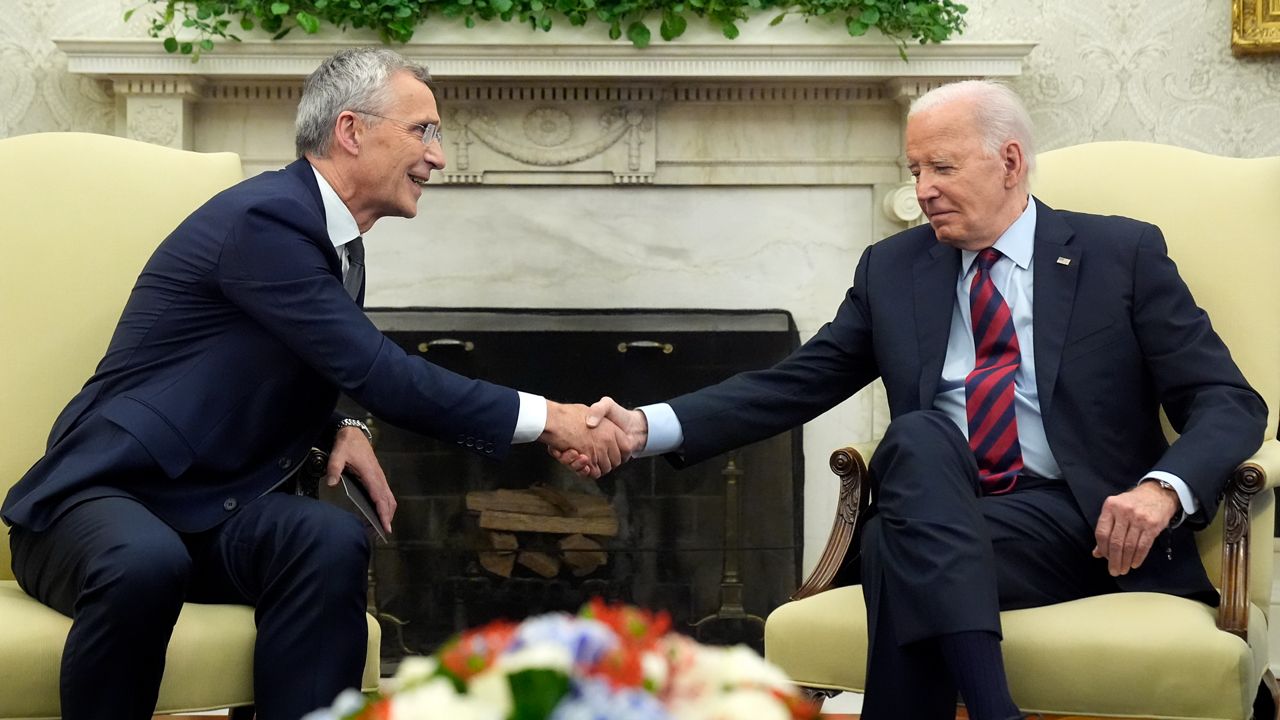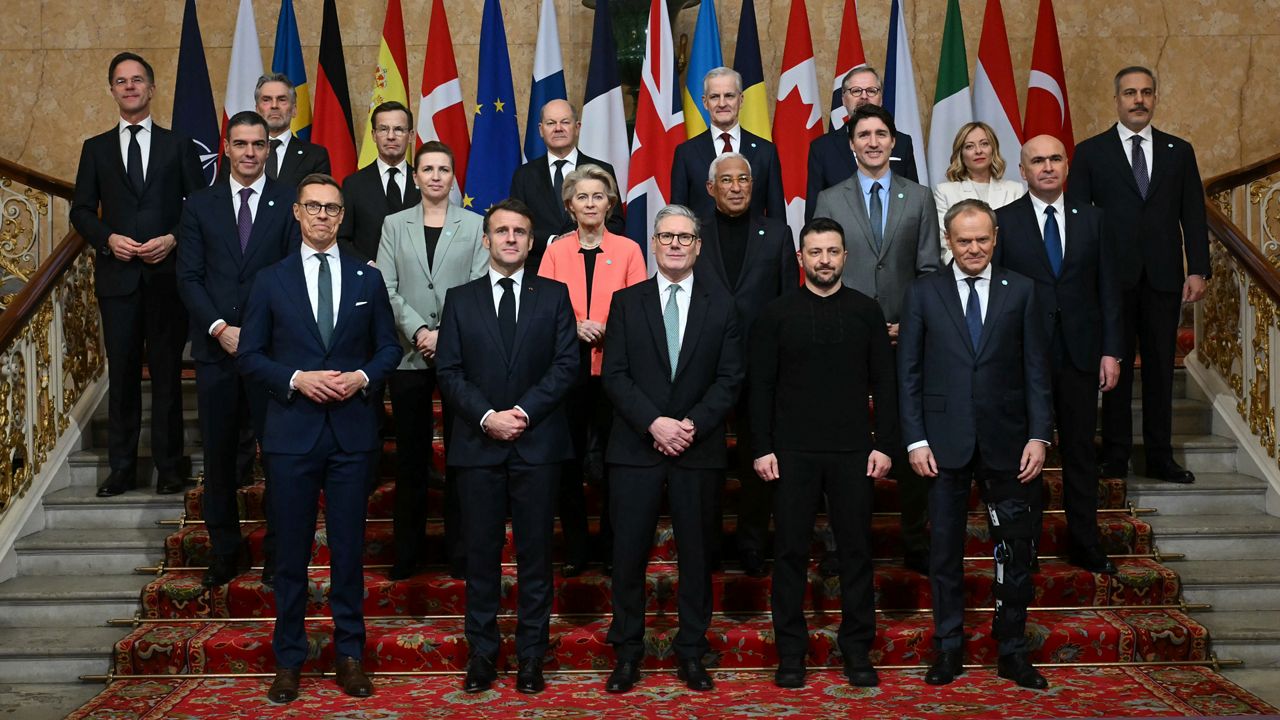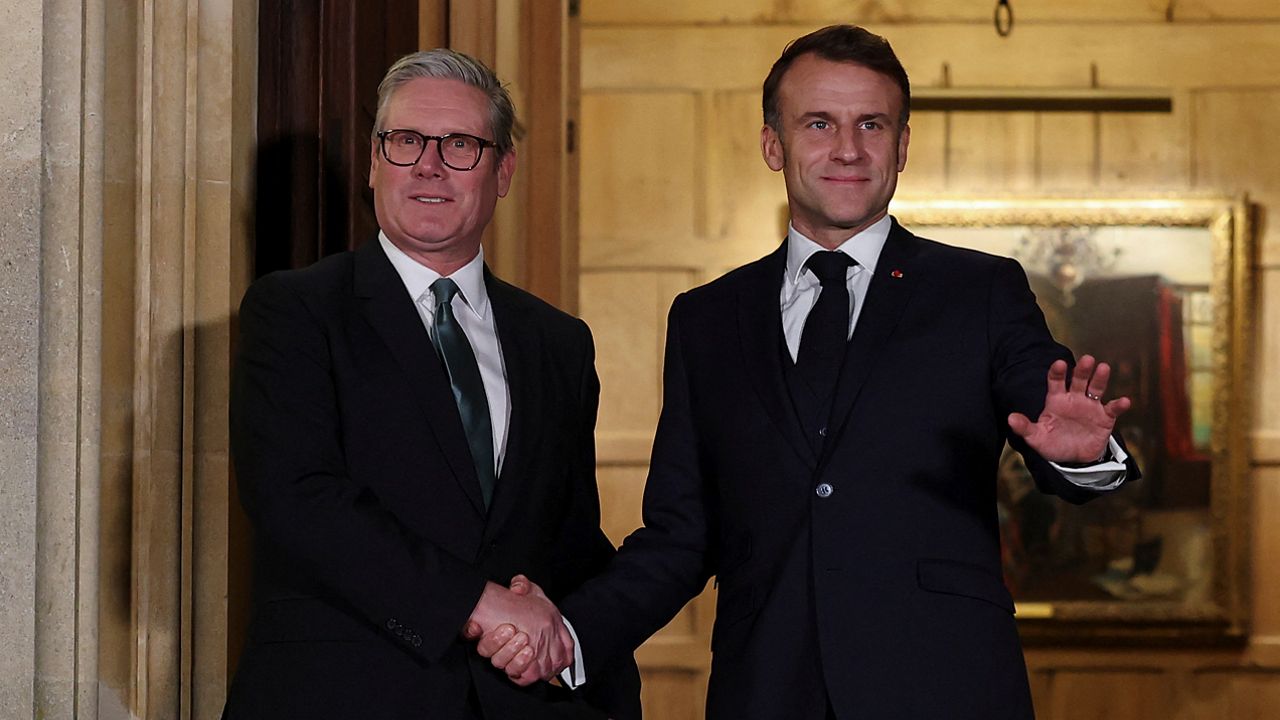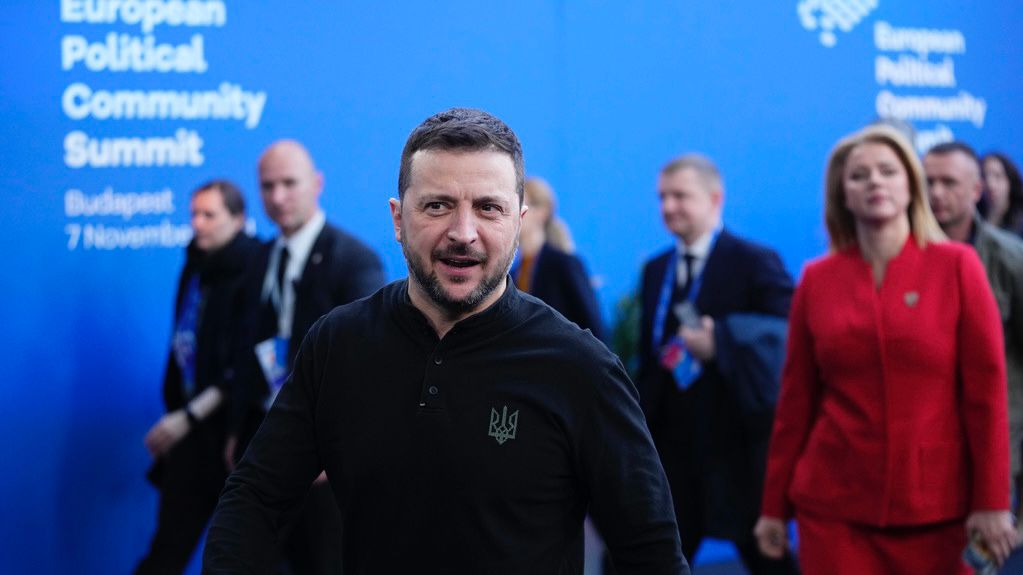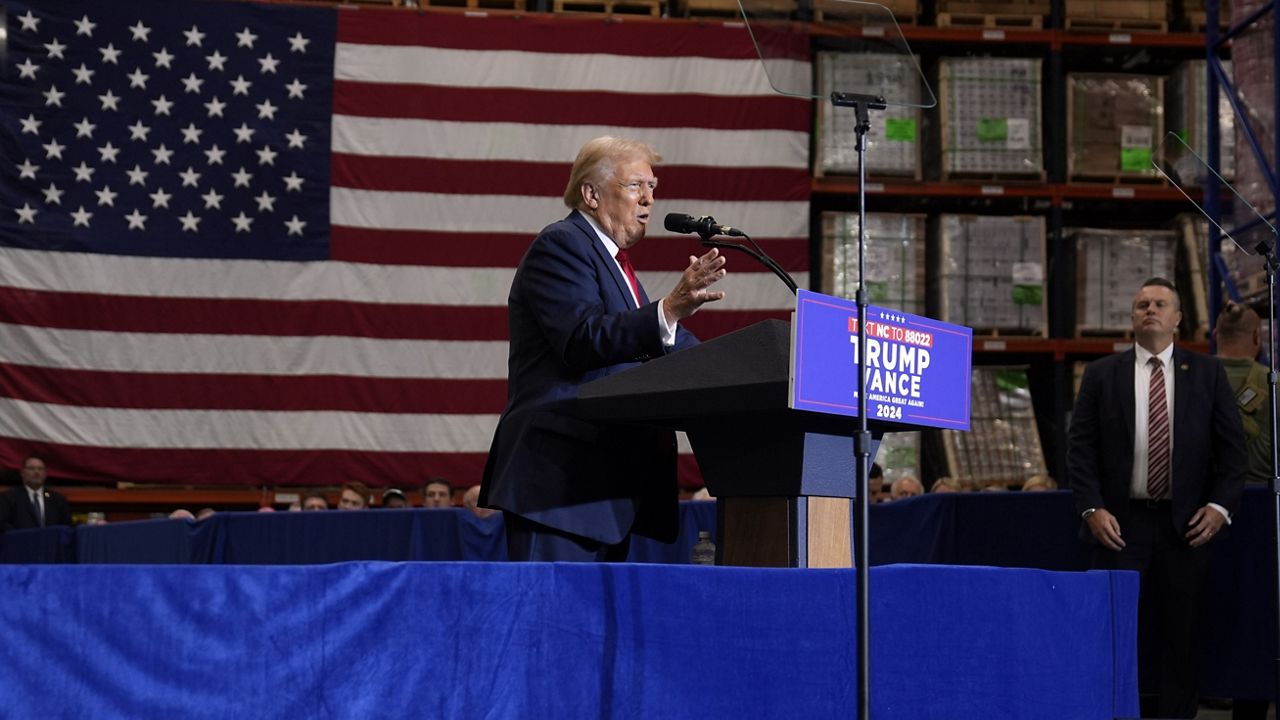NATO Secretary-General Jens Stoltenberg said during his visit to Washington on Monday that more than 20 nations in the alliance have increased defense spending to meet NATO’s guidelines, marking a record high amid the continued war in Ukraine and as the United States’ future in the alliance remains a question ahead of the November presidential election.
Stoltenberg revealed the figure during a speech at the Wilson Center, a foreign policy think tank in Washington, on Monday morning ahead of a White House visit with President Joe Biden later in the day.
“Just five years ago, there were still less than 10 allies that spent 2% of GDP on defense,” Stoltenberg said of the alliance of 30 European nations, the United States and Canada. “This year, more than 20 allies will spend at least 2% of GDP on defense. This is good for Europe and good for America, especially since much of this extra money is spent here in the United States.”
Stoltenberg went on to say “NATO creates a market for defense sales” in the U.S., noting that two-thirds of European military purchases were made with U.S. firms — to the tune of $140 billion — in the last two years.
At the White House, Biden said during brief remarks alongside Stoltenberg that they “both worked like hell to make sure” that “NATO allies have never been more united.”
“The support that we are providing to get there to Ukraine is now making a difference on the battlefield as we speak because the offensive is launched and Ukrainians are making progress, making advances,” Stoltenberg said at the Oval Office sitdown. “It's still early days, but what we do know is that the more land Ukrainians are able to liberate the stronger hand they will have at the negotiating table. And also, the more likely it will be that [Russian President Vladimir] Putin, at some stage, will understand that he will never win this war over aggression on the battlefield.”
The former Norwegian Prime Minister who has helmed the Cold War-era alliance since 2014 is in Washington ahead of the annual NATO leaders summit in the U.S. capital next month. At top of mind for his visit: a deepening European role in the Ukrainian war effort to repel Russian invaders, fear of Russian aggression spreading into NATO countries and concern that a Biden loss to former President Donald Trump in November could lead to a less alliance-friendly partner in the U.S.
“I think it is very likely that the current president could win the election,” German Chancellor Olaf Scholz told reporters with the media conglomerate Axel Springer over the weekend when asked about a potential Trump victory. Scholz also described Biden as “a man who knows exactly what he is doing” when it comes to international politics and Russia’s war in Ukraine.
Polls suggest the race is tight, with Trump polling slightly better in national surveys and in key swing states.
Trump’s attitude towards NATO comes in stark contrast to Biden, who has long emphasized the importance of NATO and other international alliances as integral to his vision of global affairs. Trump characterized many NATO allies as freeloading on U.S. military spending and said on the campaign trail that he would not defend NATO members that don’t meet defense spending targets. In February, he said he would encourage Russia “to do whatever the hell they want” to NATO members who did not pay up.
“One of them stood up and said, ‘sir, do you mean to tell me that if I'm attacked… by Russia, you will not defend me?’ I said, ‘are you delinquent?’ He said, ‘well, let's say I was.’ I said, ‘if you're delinquent, I would not protect you,’” Trump said at a New Jersey rally last month, recounting a conversation he said he had with an unidentified NATO leader during his first term.
NATO members agreed to spend at least 2% of their gross domestic product on defense, but that goal is nonbinding. Only six nations were meeting the goal in 2021, before Russian President Vladimir Putin’s full-scale invasion of Ukraine.
“Since 1949, every U.S. president, every U.S. Congress and millions of Americans have been staunch supporters of NATO because a strong NATO is in the vital national interest of the United States,” Stoltenberg said at the Wilson Center on Monday. “This was true 75 years ago. It is true today. And it will continue to be the case in the future.”
Stoltenberg's visit is laying the groundwork for what’s expected to be a pivotal summit of NATO leaders in Washington next month. The mutual-defense alliance has grown in strength and size since Russia's invasion of Ukraine two years ago, with both Sweden and Finland joining.
Defense spending by many European countries fell after the 1991 collapse of the Soviet Union seemed to neutralize what was then the prime security threat to the West.
But after Russia seized Ukraine’s Crimean Peninsula in 2014, NATO members unanimously agreed to spend at least 2% of their GDP on defense within a decade. The full-scale invasion that Putin launched in 2022 spurred European countries newly on the front line of a war in the heart of Europe to put more resources into meeting that target.
Much of the focus of the summit is expected to address what NATO and NATO member governments can do for Ukraine as it faces unrelenting air and ground attacks from its more powerful neighbor. They so far have resisted Ukrainian President Volodymyr Zelenskyy’s appeals to take his country into the bloc as long as the war is still on.
“The president has said that he believes that NATO is in Ukraine's future and there's a lot of things that have to be done before they can join the alliance like any member has to do,” White House National Security Council spokesperson John Kirby said during a briefing on Monday. “But we do believe that NATO is in Ukraine's future and we're going to work with them every step of the way.”
“I want to reiterate that joining the alliance is the alliance’s decision, it’s not something the United States can just make happen magically,” Kirby added.
Stoltenberg pointed to efforts to bolster Ukraine in the meantime. That includes NATO streamlining the eventual membership process for Ukraine, and individual NATO nations providing updated arms and training to Ukraine’s military, including the U.S. giving it F-16s and bringing Ukrainian pilots to the U.S. for training on the advanced aircraft.
“The idea is to move them so close to membership that when the time comes, when there is consensus, they can become a member straight away,” Stoltenberg said.
However Russia’s offensive concludes, only taking Ukraine into the alliance will dissuade Putin from trying again in the future to conquer Ukraine, the NATO chief said.
The prospect of Ukraine joining NATO has long been anathema to Putin, and it was one of his stated motivations for seizing Crimea. He offered last week to order an immediate cease-fire if Ukraine renounced plans to join the alliance, an offer that was dismissed by Ukraine.
A weekend conference held in Switzerland was billed as a first step toward peace and ended with pledges to work toward a resolution but had few concrete deliverables. It was attended largely by Western nations and Russia was not invited. China sat it out and then India, Saudi Arabia, South Africa and Mexico did not sign the meeting’s final document Sunday.
Kyiv’s outgunned and outnumbered forces are battling to hold back the bigger Russian army, which has taken over chunks of territory after political squabbles led to delays in delivering U.S. and European military aid. Ukraine has been short of troops, ammunition and air defenses in recent months as the Kremlin’s forces try to cripple the national power supply and punch through the front line in eastern parts of the country.
“It may seem like a paradox, but the path to peace is therefore more weapons for Ukraine,” Stoltenberg said, later adding “nobody knows when and how the the fighting will end in Ukraine, but when it ends, we have to be certain this is peace and not just a pause before Russia launches new attacks.”
“In that sense, NATO membership will also help to ensure that the war really ends, that Ukraine can prevail,” Stoltenberg continued.
The Associated Press contributed to this report.




